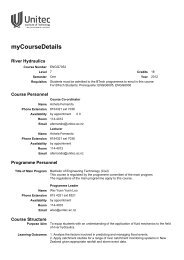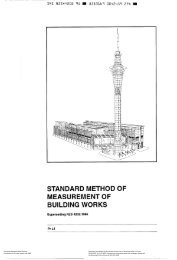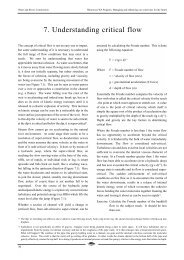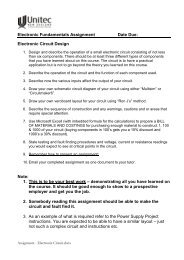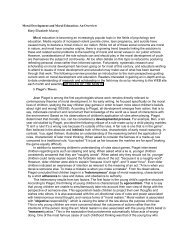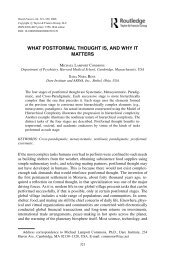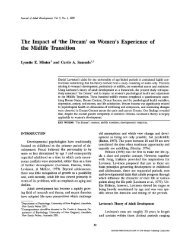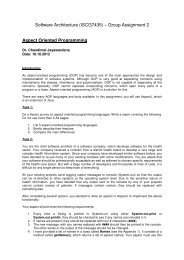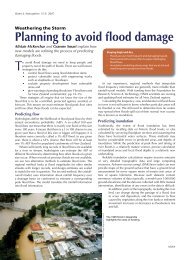You also want an ePaper? Increase the reach of your titles
YUMPU automatically turns print PDFs into web optimized ePapers that Google loves.
LEARNWELL OY<br />
Supporting you in the world of languages!<br />
BUSINESS ENGLISH 2008<br />
<strong>CHARTS</strong>, <strong>GRAPHS</strong><br />
<strong>AND</strong> <strong>DIAGRAMS</strong><br />
Learnwell Oy professional language training and translation services<br />
include:<br />
• language training, special intensive courses and custom-designed courses<br />
• translation, interpreting, proofreading and editing services<br />
• dedicated services (our X-file products) that include monthly support for ongoing<br />
small translation, editing and proofreading tasks; corporate team-building training and<br />
EXPAT services<br />
• web tools for teachers and students<br />
www.thelanguagemenu.com
Charts, graphs and diagrams Business English English<br />
Different types of charts, graphs and diagrams<br />
single line graph<br />
multiple line graph paired bar chart<br />
percentage bar chart pie chart stacked bar chart<br />
single bar chart diagram population chart<br />
flow chart bar graph bubble diagram<br />
Pictures from Google images<br />
English materials by Veronica Gilhooly © Learnwell Oy 2008<br />
www.thelanguagemenu.com<br />
Business English<br />
Page 1
Charts, graphs and diagrams Business English English<br />
Before you Begin<br />
Writing about Graphs<br />
Underline key words. Write related words - turn nouns into verbs, verbs into nouns, adjectives into<br />
adverbs, etc. Write opposite words, similar words, synonyms, etc.<br />
Circle and highlight the graph. Use arrows. Make notes. Circle the biggest, the smallest. stable or<br />
unchanging parts, sudden increases, etc.<br />
Identify trends. A trend is the overall idea of the graph<br />
• what is happening/what happened<br />
• the main change over time<br />
• the most noticeable thing about the graph<br />
• the pattern over time<br />
• the pattern for different places or groups or people.<br />
Most graphs will have two trends, or there will be two graphs with a trend in each. You could tell<br />
about the two trends in two separate paragraphs. Make sure you have identified the trends in the graph.<br />
Introduction<br />
• First sentence: Describe the graph. You can use some slightly different words or word<br />
forms from those on the question paper, but be careful to give the full information. Start "The<br />
graph shows"<br />
• Second sentence: This gives the trend or trends. You can put two trends in this sentence<br />
or only one - you could keep the other one for the conclusion. Start "Overall, ..."<br />
Paragraph 1: Trend 1<br />
• Start with a sentence with no number. “City size increased sharply over the period.” “The<br />
most obvious trend in the graph is that women are having fewer babies.” “Oil production has<br />
increased slightly in all the countries in the graph”<br />
• Follow this sentence with an example (sentence with number) and perhaps another<br />
example (another sentence with number). Keep alternating.<br />
Paragraph 2: Trend 2<br />
Conclusion<br />
• Start with a sentence with no number. “City size increased sharply over the period.”<br />
• Give an example (sentence with number) and perhaps another example<br />
English materials by Veronica Gilhooly © Learnwell Oy 2008<br />
www.thelanguagemenu.com<br />
Business English<br />
Page 2
Charts, graphs and diagrams Business English English<br />
• Finish by repeating the main trends, or identify a second trend. Use different vocabulary.<br />
• Don't have any numbers in the conclusion (you could use words like "most", "the<br />
majority" "a minority", "a small number").<br />
• Don’t give an opinion.<br />
While You Write: Some Don’ts<br />
Word Length<br />
• Don’t describe the X and Y axis. Give the information.<br />
• Don’t write about everything on the graph. Pick the biggest, the smallest, the main<br />
points, the main trends. Group similar things together<br />
• Don’t write about the line or the bar: “The line went up,” “The bar went down.”<br />
Instead, write about the idea. “The number of people going to work by train increased<br />
gradually.” “Oil production shot up in 1965”<br />
• Make sure you write about the idea. Don’t use shorthand: “Men went up.” “Women went<br />
down.” Instead, write about the real data: “The number of men at university fell dramatically,”<br />
“The percentage of female students getting a degree rose suddenly.”<br />
• Don’t use “I feel”, “as I have written,” “as you can see,” etc. Keep it academic.<br />
• Don’t start sentences with But, So, Also, And, For, Since, Because, Although<br />
Make sure you have 150 words. You should have some short sentences (about 6-10 words) and<br />
some long ones (12-18) words, but your average should be about 12 or 13 words per sentence.<br />
A sentence without a number will usually be short. Use a mix - a sentence without a number<br />
followed by a sentence or two with a number.<br />
http://www.admc.hct.ac.ae/hd1/english/graphs/writingaboutgraphs.htm<br />
English materials by Veronica Gilhooly © Learnwell Oy 2008<br />
www.thelanguagemenu.com<br />
Business English<br />
Page 3
Charts, graphs and diagrams Business English English<br />
h<br />
Place the words in the right column, then add a few more words of your own<br />
be constant climb collapse cut<br />
expansion extension fall go down<br />
growth improvement level off push down<br />
reduction rise shoot up soar<br />
stability stagnation stand at stay at<br />
Verbs<br />
Verbs<br />
Verbs<br />
Verbs<br />
Verbs<br />
Verbs<br />
Nouns<br />
Nouns<br />
Nouns<br />
Nouns<br />
Nouns<br />
Nouns<br />
English materials by Veronica Gilhooly © Learnwell Oy 2008<br />
www.thelanguagemenu.com<br />
Business English<br />
Page 4
Charts, graphs and diagrams Business English English<br />
Transitive and intransitive verbs<br />
A transitive verb is an action<br />
verb. Second, it requires a<br />
direct object to complete its<br />
meaning in the sentence. In<br />
other words, the action of the<br />
verb is transferred to the<br />
object directly. To determine<br />
whether a verb is transitive, ask<br />
whether the action is done to<br />
someone or something.<br />
An intransitive verb is an<br />
action verb, but it does not<br />
have a direct object. The<br />
action ends rather than being<br />
transferred to some person or<br />
object or is modified by an<br />
adverb or adverb phrase.<br />
increase decrease maintain increase decrease stay at<br />
raise drop keep rise drop reach a peak<br />
step up cut grow decline remain stable<br />
expand go down expand fall<br />
improve<br />
improve<br />
Write sentences using the transitive and intransitive verbs<br />
1. ______________________________________________________________________<br />
2. ______________________________________________________________________<br />
3. ______________________________________________________________________<br />
4. ______________________________________________________________________<br />
5. ______________________________________________________________________<br />
6. ______________________________________________________________________<br />
7. ______________________________________________________________________<br />
8. ______________________________________________________________________<br />
9. ______________________________________________________________________<br />
10. ______________________________________________________________________<br />
English materials by Veronica Gilhooly © Learnwell Oy 2008<br />
www.thelanguagemenu.com<br />
Business English<br />
Page 5
Charts, graphs and diagrams Business English English<br />
Introduction to Pie Charts<br />
You are usually asked to compare 2 pie charts but sometimes you only have 1 chart to describe.<br />
Single Pie Chart<br />
Paragraph 1<br />
Describe what sort of chart it is and what it is about.<br />
Paragraph 2<br />
Describe the sections of the graph starting with the biggest and working your way down.<br />
Paragraph 3<br />
A short conclusion giving an overall view of what the chart is about.<br />
Two Pie Charts<br />
If you have 2 pie charts they will be giving similar information so you can compare the two. This type<br />
of writing is similar to a compare and contrast essay.<br />
Paragraph 1<br />
Explain that they are pie charts and say what they are describing. This is the same as line graphs except<br />
there are 2.<br />
Paragraph 2<br />
Compare the data between the two charts. Start with the biggest sectors and work your way down.<br />
Paragraph 3<br />
Conclusion. Mention the important similarities and differences.<br />
English materials by Veronica Gilhooly © Learnwell Oy 2008<br />
www.thelanguagemenu.com<br />
Business English<br />
Page 6
Charts, graphs and diagrams Business English English<br />
Fill in the correct word<br />
a low point declined doubled drop<br />
from increased slightly recovered remained<br />
rising sharply sudden to were<br />
In January, gold sales _____________ about 200 million dirhams per month. In February they<br />
_____________ to Dhs 220 million, _____________ to a peak of 350 million dirhams in March. Over<br />
the next four months, sales _____________ steadily, reaching _____________ of 120 million dirhams<br />
in July.<br />
In August, there was a _____________ increase. Sales almost _____________, rising _____________<br />
Dhs 120 million in July to Dhs 210 million in August. This was followed by a [?] in September to Dhs<br />
120 million.<br />
From September to October, sales _____________ from Dhs 120 million to Dhs 180 million. In<br />
October and November, sales _____________steady, and there was a small increase in December<br />
_____________ 190 million dirhams.<br />
http://www.admc.hct.ac.ae/hd1/english/graphs/goldsales.htm<br />
English materials by Veronica Gilhooly © Learnwell Oy 2008<br />
www.thelanguagemenu.com<br />
Business English<br />
Page 7
Charts, graphs and diagrams Business English English<br />
Place the correct letter in the box<br />
slump rise recover plunge pick up plummet<br />
drop soar climb fall rally bounce back<br />
take off crash escalate slide stabilize flatten out<br />
decline rocket dip fluctuate hold steady<br />
A B C D E F G<br />
Expressing approximation<br />
We use words to express approximation when the point we are trying to describe is<br />
between milestones on the graph.<br />
just under<br />
just over<br />
well under<br />
well over<br />
roughly<br />
nearly<br />
approximately<br />
around<br />
about<br />
English materials by Veronica Gilhooly © Learnwell Oy 2008<br />
www.thelanguagemenu.com<br />
Business English<br />
Page 8
Charts, graphs and diagrams Business English English<br />
Expressing the Movement of a Line<br />
Verbs Nouns Adjectives Adverbs<br />
rise (to) a rise dramatic dramatically<br />
increase (to) an increase sharp sharply<br />
go up to huge hugely<br />
grow (to) growth steep steeply<br />
climb (to) a climb substantial substantially<br />
boom a boom considerable considerably<br />
peak (at) (reach) a peak (at) significant significantly<br />
fall (to) a fall (of) marked markedly<br />
decline (to) a decline (of) moderate moderately<br />
decrease (to) a decrease (of) slight slightly<br />
dip (to) a dip (of) small<br />
drop (to) a drop (of) minimal minimally<br />
go down (to)<br />
reduce (to)<br />
a reduction (of)<br />
a slump<br />
level out<br />
a leveling out<br />
no change<br />
no change<br />
remain stable (at)<br />
remain steady (at)<br />
stay (at)<br />
stay constant (at)<br />
maintain the same level<br />
Describing the Speed of a Change<br />
Adjectives<br />
rapid<br />
quick<br />
swift<br />
sudden<br />
steady<br />
gradual<br />
slow<br />
Adverbs<br />
rapidly<br />
quickly<br />
swiftly<br />
suddenly<br />
steadily<br />
gradually<br />
slowly<br />
English materials by Veronica Gilhooly © Learnwell Oy 2008<br />
www.thelanguagemenu.com<br />
Business English<br />
Page 9
Charts, graphs and diagrams Business English English<br />
1. The market is showing some signs of growth. _____<br />
2. The market is extremely volatile. _____<br />
3. The pound slipped back against the dollar. _____<br />
4. The Swiss franc is staging a recovery. _____<br />
5. The yen lost ground slightly. _____<br />
6. There's been a dramatic downturn in the market. _____<br />
7. There's been an upsurge of interest in gold. _____<br />
8. The share price bottomed out at 11 cents. _____<br />
9. Gold peaked at €300 an ounce. _____<br />
10. Profits will level off at around €10,000. _____<br />
11. Sales hit an all-time low. _____<br />
12. There hasn't been much movement in the price of tin _____<br />
http://www.admc.hct.ac.ae/hd1/english/graphs/movement.htm<br />
English materials by Veronica Gilhooly © Learnwell Oy 2008<br />
www.thelanguagemenu.com<br />
Business English<br />
Page 10
Charts, graphs and diagrams Business English English<br />
Comparing and contrasting<br />
One syllable<br />
Adjectives with one syllable form their comparatives and superlatives like this:<br />
cheap cheaper cheapest<br />
large larger largest<br />
bright brighter brightest<br />
Exceptions:<br />
good better best<br />
bad worse worst<br />
Two syllables<br />
Some adjectives with two syllables form their comparatives and superlatives like this:<br />
pretty prettier prettiest<br />
happy happier happiest<br />
But many form their comparatives and superlatives like this:<br />
striking more striking most striking<br />
Although some can form their comparatives and superlatives like this:<br />
common more common most common<br />
clever more clever / cleverer most clever /cleverest<br />
Three or more syllables<br />
All adjectives with three or more syllables form their comparatives and superlatives like this:<br />
attractive more attractive most attractive<br />
profitable more profitable most profitable<br />
expensive more expensive most expensive<br />
English materials by Veronica Gilhooly © Learnwell Oy 2008<br />
www.thelanguagemenu.com<br />
Business English<br />
Page 11
Charts, graphs and diagrams Business English English<br />
What are the comparative and superlative forms of these adjectives<br />
Adjective Comparative Superlative<br />
accurate<br />
certain<br />
convenient<br />
correct<br />
dangerous<br />
happy<br />
likely<br />
modern<br />
new<br />
possible<br />
probable<br />
up-to-date<br />
http://international.holmesglen.vic.edu.au/ielts_writing.pdf<br />
English materials by Veronica Gilhooly © Learnwell Oy 2008<br />
www.thelanguagemenu.com<br />
Business English<br />
Page 12
Charts, graphs and diagrams Business English English<br />
Introducing visuals<br />
• I'd like you to look at this graph...<br />
• Let me show you this pie chart...<br />
• Let's have a look at this model...<br />
• Let's turn to this map...<br />
• To illustrate my point let’s look at some diagrams...<br />
• As you can see from these figures...<br />
• If you look at these photographs you'll see...<br />
• If you look at this bar chart you'll notice...<br />
• If you look at this histogram you'll appreciate...<br />
• If you look at this flow chart you'll understand ...<br />
• If you look at this matrix...<br />
Naming the parts of diagrams<br />
The vertical axis represents total annual sales. The horizontal axis shows our market share. The curve,<br />
The solid line, The dotted line, The broken line, The shaded area, The unshaded section, The dotted<br />
column, The coloured segment, The red bar…<br />
English materials by Veronica Gilhooly © Learnwell Oy 2008<br />
www.thelanguagemenu.com<br />
Business English<br />
Page 13
Charts, graphs and diagrams Business English English<br />
Explaining diagrams<br />
• Sales rose slightly in the final quarter.<br />
• Profits fell a little last year.<br />
• Demand increased gently<br />
• Turnover decreased steadily<br />
• Turnover dropped suddenly<br />
• Turnover decreased quickly.<br />
• Demand increased rapidly.<br />
• Profits fell dramatically.<br />
• At the beginning of this year sales stagnated.<br />
• In the middle of August profits slumped.<br />
• At the end of last year demand peaked.<br />
• In the first quarter of 2008 sales plummeted.<br />
• In the second quarter of 2007 sales flattened out.<br />
• In the third quarter of 2007 sales leveled off.<br />
• In the last quarter of 2007 sales remained steady.<br />
English materials by Veronica Gilhooly © Learnwell Oy 2008<br />
www.thelanguagemenu.com<br />
Business English<br />
Page 14
Charts, graphs and diagrams Business English English<br />
Useful phrases for presentations<br />
Signalling a start:<br />
- Right, ladies and gentlemen. Shall we begin?<br />
- OK, I'd like to begin by ...<br />
- Right then, everybody ...<br />
Greetings:<br />
- Good morning, ladies and gentlemen.<br />
- I'd like to welcome you all on behalf of NKS.<br />
- I'd like to say how happy I am to be here today.<br />
Introducing yourself:<br />
- My name is Richard Delmas.<br />
- I'm the Marketing Manager here.<br />
- I'd like to introduce myself. My name is ...<br />
- Let me introduce myself. My name is ...<br />
Introducing people:<br />
- I'd like to introduce Mr Peters from Datacom.<br />
- May I introduce ...<br />
- Let me introduce ...<br />
The objective of your presentation:<br />
- My objective this afternoon is to inform you...<br />
- I'm here today to give you...<br />
- My purpose today is to introduce you to...<br />
- My aim this morning is to...<br />
The length of time your presentation will take:<br />
- My presentation will last twenty-five minutes.<br />
- I will talk for fifteen minutes.<br />
Structuring:<br />
- My presentation is split into three key areas.<br />
- Firstly ... Secondly ... Thirdly ...<br />
- To begin with ... After this ... Finally ...<br />
English materials by Veronica Gilhooly © Learnwell Oy 2008<br />
www.thelanguagemenu.com<br />
Business English<br />
Page 15
Charts, graphs and diagrams Business English English<br />
Saying when your audience may ask questions:<br />
- There will be time for questions at the end...<br />
- Please feel free to interrupt me as I go along.<br />
Introducing topics:<br />
- I want to look at ...<br />
- I'd like to review ...<br />
- I want to discuss ...<br />
- I'm going to analyse ...<br />
- I want to cover ...<br />
- I'd like to talk about ...<br />
Moving on:<br />
- Let's now move on to ...<br />
- I'd like to go on to ...<br />
- This brings me to ...<br />
- I now want to ...<br />
Looking back:<br />
- Let's look back for a moment ...<br />
- To go back to ...<br />
- As I said before ...<br />
Adding:<br />
- In addition ...<br />
- I might add that ...<br />
- Furthermore ...<br />
- Moreover ...<br />
Dealing with interruptions:<br />
- Perhaps I could return to that point later on?<br />
- If I might just finish?<br />
- If you'd allow me to continue?<br />
Summarising and concluding<br />
- To sum up then, ...<br />
- To summarise my main points ...<br />
- I'd like to conclude by reminding you that ...<br />
- Let me end by ...<br />
- I'd like to finish ...<br />
- In conclusion, may I remind you ...<br />
- Finally, ...<br />
English materials by Veronica Gilhooly © Learnwell Oy 2008<br />
www.thelanguagemenu.com<br />
Business English<br />
Page 16
Charts, graphs and diagrams Business English English<br />
Asking for questions:<br />
- You no doubt have many questions ...<br />
- If there are any questions ...<br />
- I'm sure you have many questions ...<br />
Playing for time:<br />
- That's an interesting question.<br />
- I'm glad you asked that question.<br />
- You've raised an important point<br />
there.<br />
- That's a difficult question.<br />
Closing question time:<br />
- Perhaps on that note we could end?<br />
- I'm afraid that's all we have time for.<br />
Thanking:<br />
- I'd like to thank you all on behalf of Company X.<br />
- I'd like to thank you all for your participation.<br />
Now choose a topic, draw a graph or a diagram and make your own<br />
presentation.<br />
English materials by Veronica Gilhooly © Learnwell Oy 2008<br />
www.thelanguagemenu.com<br />
Business English<br />
Page 17
Contact information<br />
Learnwell Oy<br />
Tehtaankatu 7<br />
00140 Helsinki<br />
Finland<br />
General inquiries: office@thelanguagemenu.com<br />
Phone: +358 45 130 1114<br />
MD: veronica.gilhooly@thelanguagemenu.com Tel: 050 531 1453<br />
Translations: translations@thelanguagemenu.com Tel: 045 112 9724<br />
www.thelanguagemenu.com



